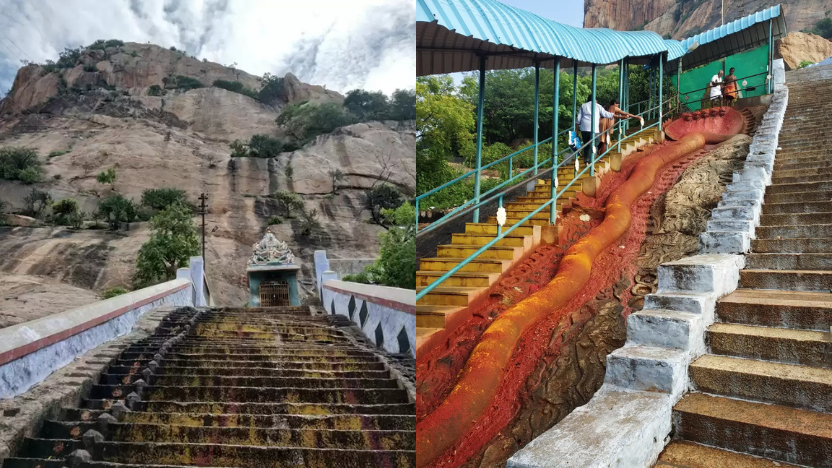Located atop the serene 650-foot hill of Tiruchengode, the ancient Sri Arthanareeswarar Temple is a rare and powerful shrine where Lord Shiva and Goddess Parvati are enshrined in a single form – Ardhanareeswarar, the divine embodiment of masculine and feminine energies in perfect harmony. This unique manifestation, also called Madhorubagan or Ammayappan, is said to be found as the prime deity only here in the whole of Asia.
The temple, believed to be over 2000 years old, has been revered through centuries by kings, poets, and devotees. Inscriptions on its walls and mentions in the ancient Tamil epic Silappadikaram attest to its historic and spiritual significance. It is considered the 4th of the 7 Tevara Stalams in the Kongu Region of Tamil Nadu.
The hill itself is considered sacred, believed to represent a Shiva Lingam, with a grand Nandi installed before it. The red hue of the hill, earning it the name Chemmalai, is linked to divine legends – from the blood of Adi Seshan during his cosmic battle with Vayu, to the blessings of Kamadhenu who received this as one of the five hills granted by Lord Shiva. This colour, along with patches of golden-yellow stone, is said to represent the union of Shiva and Shakti.
The temple is renowned for its divine power in alleviating Naga Dosham, Rahu Dosham, Kalasarpa Dosham, and Kalathira Dosham. A magnificent 60-foot Naga idol, carved directly into the rock, draws countless devotees seeking relief from serpentine afflictions and blessings for family harmony. Many couples come here to pray for a stronger marital bond, and it is believed that circumambulating the hill on a full moon day bestows the merit of circling both Kailash and Sri Vaikundam themselves.
Two powerful legends surround this temple’s origin:
1. The Kedara Gowri Vratam – Lord Adi Kesava Perumal, enshrined in a separate sanctum here, instructed Goddess Gowri in the observance of the Kedara Gowri Vratam. Through this penance, She united with Lord Shiva in the form of Ardhanareeswarar, one of Shiva’s 64 divine manifestations.
2. The Battle of Adi Seshan and Vayu – A cosmic contest between the serpent Adi Seshan and the Wind God Vayu led to a fragment of Mount Meru being blown to Tiruchengode. Adi Seshan’s blood stained the rocks red, while Vayu’s force shaped the hill.
The hill is also called Nandhi Malai and Naga Malai, separated by a valley known as Nagar Pallam. At this spot, a carved five-hooded serpent shelters a Shiva Lingam, with the sacred rivers Ganga, Yamuna, and Saraswati believed to flow above its hoods in subtle form. Devotees offer kumkum, camphor, and even prepare Pongal in worship here.
Among the 1,206 stone steps leading to the hilltop sanctum, sixty are unlike any others – the Sathya Padi or Arubadam Padi. These lie between steps 660 and 720 and hold a profound place in the temple’s history. Ancient Tamil poet-saint Arunagirinathar praises their significance.
In earlier times, these steps were a sacred platform for truth and justice. Those embroiled in disputes or court matters would stand upon the 60th step and declare their statements before the gathered public. It was believed that no falsehood could be uttered here, for the divine presence would compel truthfulness. Such declarations were once even accepted as binding evidence by the rulers of the land – and are said to have been recognised by the Madras High Court in historic cases.
Whether arriving by the motorable road or climbing each of the 1,206 steps, devotees experience a deep sense of connection as they ascend. The journey is both a physical and spiritual climb, culminating in the darshan of Lord Arthanareeswarar, radiating compassion from His hilltop abode, offering salvation and blessings to all who seek Him.
Source / Image Credit : Hill Temples, Tamil Brahmins, om_namah_shivaya555







